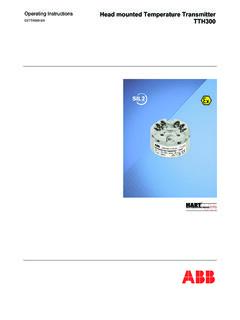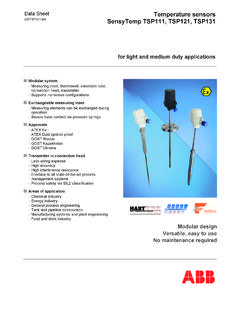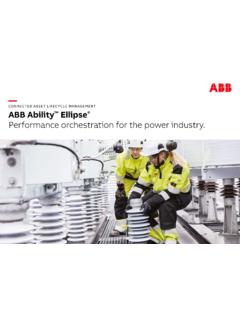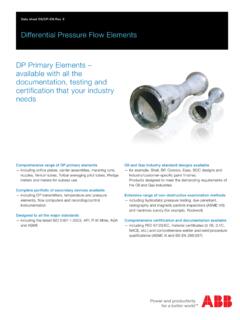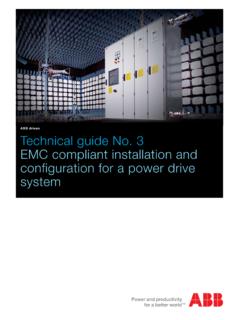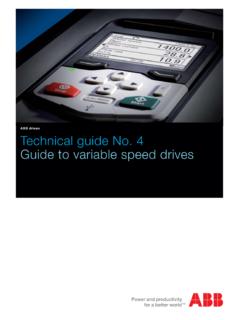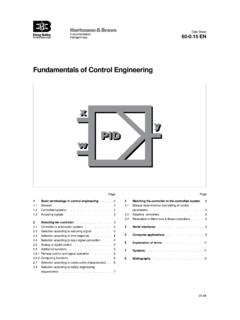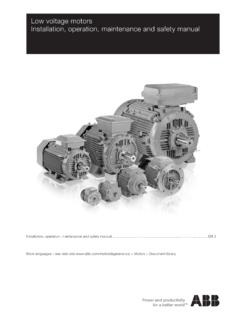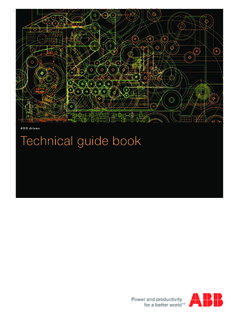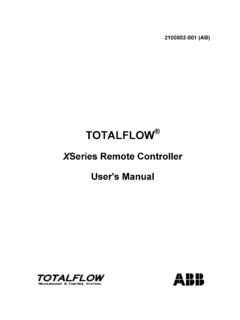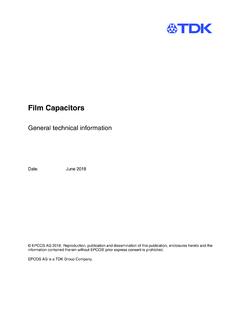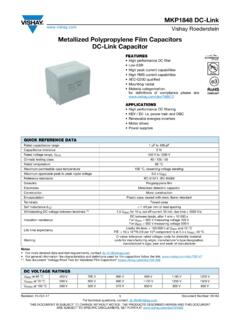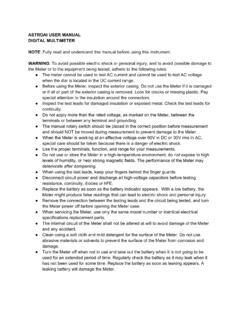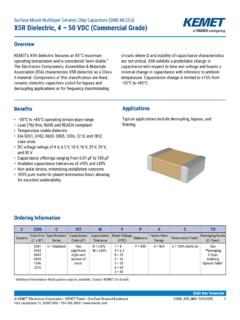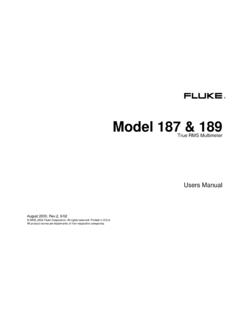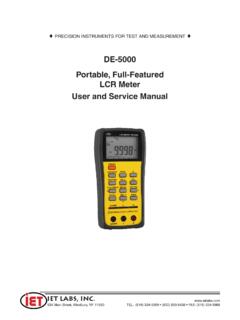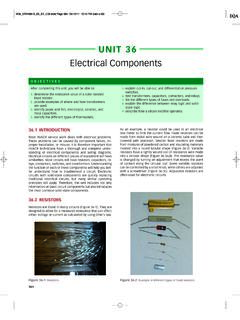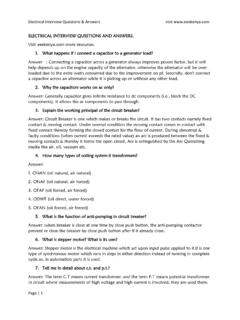Transcription of Instrument Transformers Application Guide
1 Instrument TransformersApplication Guide2 Application Guide | ABB Instrument TransformersInstallations with ABB Outdoor Instrument TransformersSubstation in Sweden with cold climate. ABB equipment with IMB in Oman with dessert climate. ABB equipment with IMB transformer IMB 420. Installation in 420 E2 with current transformer IMB 420. Installation in in Oman with dessert climate. ABB equipment with IMB voltage Transformers EMF 145. Installed in Instrument Transformers | Application Guide 34 Application Guide | ABB Instrument TransformersTable of contents1. General principles of measuring current and Instrument Current Transformers operating Measuring Calculation of Variation of errors with Saturation Core Voltage Transformers operating Measuring Determination of Calculation of the short-circuit impedance Variation of errors with Winding Accuracy and burden Capacitor Voltage Transformer (CVT)
2 Characteristics of a The CVT at no-load The CVT at Calculation of internal resistance and load point for other burden than Inclination of the load Frequency dependence of a Error changes for voltage Different power factor of the Error variation for temperature Quality Leakage currents and stray capacitance Transient Transient Ferro-resonance352. How to specify current Rated insulation Altitude above sea Rated primary Rated continuous thermal Rated secondary Short-time thermal current (Ith) and dynamic current (Idyn) Burdens and accuracy Measurement of Metering Relay Excitation Accuracy classes according to IEC Accuracy classes according to IEEE Pollution levels52 ABB Instrument Transformers | Application Guide 53.
3 Measurement of current during transient The Important Rated primary current (Ipn) Rated secondary current (Isn) Rated primary symmetrical short-circuit current (Ipsc) Secondary burden (Rb) Specified duty cycle (C-O and C-O-C-O) Secondary-loop time constant (Ts) Rated symmetrical short-circuit current factor (Kssc) Rated transient dimensioning factor (Ktd) Flux overcurrent factor (nf) Maximum instantaneous Air gapped Remanent flux ( r) Remanence factor (Kr) Accuracy classes for transient cores according to IEC Error limits for TPX, TPY and TPZ current How to specify current Transformers for transient performance614. How to specify voltage Type of voltage Rated insulation Rated insulation levels according to Basic insulation levels according to Rated primary and secondary Rated voltage factor (FV) Burdens and accuracy Pollution Transient response for capacitor voltage Transient response for inductive voltage Ferro-resonance in capacitor voltage Ferro-resonance in inductive voltage Voltage drops in the secondary Coupling CVTs as coupling Measure harmonics with VTs765.
4 Design of current Hair-pin type (Tank type) Cascade/Eye-bolt Top core Combined current-voltage type826 Application Guide | ABB Instrument TransformersTable of Mechanical stress on current Forces on the primary Wind Seismic withstand846. Design of inductive voltage Mechanical stress on inductive voltage Forces on the primary Seismic withstand and wind load867. Design of capacitor voltage External disturbances on capacitor voltage Mechanical stress on capacitor voltage Seismic properties of ABB s capacitor voltage transformers928. Instrument Transformers in the Terminal designations for current Terminal designations for voltage Terminal designations for capacitor voltage Secondary grounding of current Secondary grounding of voltage Connection to obtain the residual Fusing of voltage transformer secondary Location of current and voltage Transformers in Location of current Transformer and reactor bushing current Physical order of cores in a current Location of voltage transformers1049.
5 Protective Current transformer Fault Secondary wire resistance and additional General current transformer Rated equivalent secondary Line distance protection REL 670 and REL Line differential protection Line differential Line distance Transformer protection RET670 and Transformer differential Restricted earth fault protection (low impedance differential) Busbar protection Busbar differential Breaker failure Non-directional instantaneous and definitive time, phase overcurrent Non-directional inverse time delayed phase overcurrent protection117 ABB Instrument Transformers | Application Guide Bay control REC670 and Circuit breaker failure Non-directional instantaneous and definitive time, phase and residual overcurrent Non-directional inverse time delayed phase and residual overcurrent Directional phase and residual overcurrent Line distance protection REL670 (REL501, REL511, REL521, REL531) Line distance Line differential protection RED670 (REL551, REL561) Line differential Line distance function, additional for RED670 (REL561)
6 Transformer protection RET670 (RET521) and transformer differential protection Busbar protection REB670 (RED521) High impedance differential protection Pilot-wire differential relay Current transformer requirements for CTs according to other Current Transformers according to IEC 61869-2, class P, Current Transformers according to IEC 61869-2 class PX, Current Transformers according to ANSI/IEEE12810. Non Coventional Instrument Fiber Optic Current Sensor (FOCS) DOIT Technical description1328 Application Guide | ABB Instrument Instrument TransformersThe main tasks of Instrument Transformers are: To transform currents or voltages from a usually high value to a value easy to handle for relays and instruments.
7 To insulate the metering circuit from the primary high voltage system. To provide possibilities of standardizing the instruments and relays to a few rated currents and voltages. Instrument Transformers are special types of Transformers intended to measure cur-rents and voltages. The common laws for Transformers are transformersFor a short-circuited transformer the following is valid:1122 This equation gives current transformation in proportion to the primary and secondary turns. A current transformer is ideally a short-circuited transformer where the secondary ter-minal voltage is zero and the magnetizing current is transformersFor a transformer in no load the following is valid:1212 This equation gives voltage transformation in proportion to the primary and secondary turns.
8 A voltage transformer is ideally a transformer under no-load conditions where the load current is zero and the voltage drop is only caused by the magnetizing current and is thus Current Transformers operating principlesA current transformer is, in many respects, different from other Transformers . The primary is connected in series with the network, which means that the primary and secondary currents are stiff and completely unaffected by the secondary burden. The currents are the prime quantities and the voltage drops are only of interest regarding excitation current and measuring General principles of measuring current and voltageABB Instrument Transformers | Application Guide Measuring errors Figure the excitation current could be neglected the transformer should reproduce the primary current without errors and the following equation should apply to the pri-mary and secondary currents:In reality, however, it is not possible to neglect the excitation current.
9 Figure shows a simplified equivalent current transformer diagram converted to the secondary side. Figure diagram shows that not all the primary current passes through the secondary circuit. Part of it is consumed by the core, which means that the primary current is not reproduced exactly. The relation between the currents will in this case be:BurdenI2I1 BurdenI2Ie(N1 / N2) x I1 ExcitationImpedance10 Application Guide | ABB Instrument Transformers1. General principles of measuring current and voltageThe error in the reproduction will appear both in amplitude and phase. The error in amplitude is called current or ratio error and the error in phase is called phase error or phase displacement. Figure Figure Figure shows a vector representation of the three currents in the equivalent dia-gram.
10 Figure shows the area within the dashed lines on an enlarged Figure the secondary current has been chosen as the reference vector and given the dimension of 100%. Moreover, a system of coordinates with the axles divided into percent has been constructed with the origin of coordinates on the top of the reference vector. Since d is a very small angle, the current error e and the phase error d could be directly read in percent on the axis (d = 1% = 1 centiradian = minutes).I2Ie(N1 / N2) x I1 I2 = 100%(I1 / I2) x (N1 / N2) x 100%(Ie / I2) x 100% ABB Instrument Transformers | Application Guide 11 According to the definition, the current error is positive if the secondary current is too high, and the phase error is positive if the secondary current is leading the primary.
